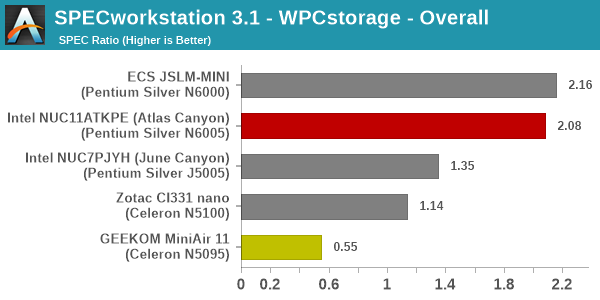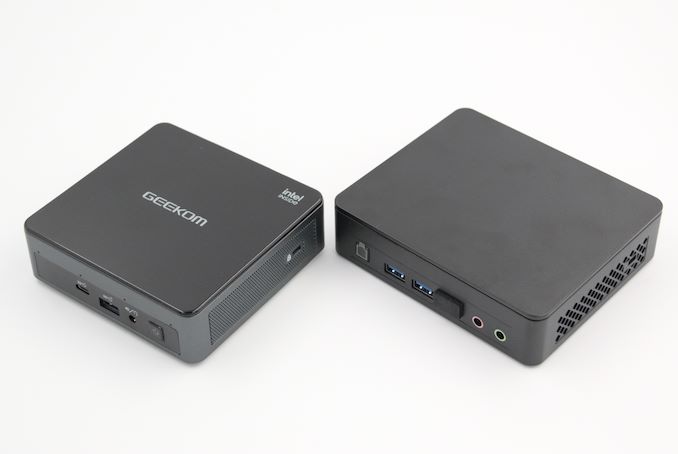Intel Atlas Canyon (NUC11ATKPE) and GEEKOM MiniAir 11 UCFF PCs Review: Desktop Jasper Lake Impresses
by Ganesh T S on July 14, 2022 8:00 AM ESTMiscellaneous Aspects and Concluding Remarks
Networking and storage are aspects that may be of vital importance in specific PC use-cases. The Intel NUC11ATKPE (Atlas Canyon) and the GEEKOM MiniAir 11 both come with a single LAN port backed by the Realtek RTL8111/8168 combination. The WLAN solution is a bit more interesting. While the NUC11ATKPE uses the more recent Wireless-AC 9462, the MiniAir 11 uses the Wireless-AC 7265. The former is a 1x1 solution with maximum theoretical rate of 433 Mbps, while the latter is a 2x2 solution (867 Mbps). However, the 9462 includes dynamic antenna diversity support, while the 7265 doesn't. So, in congested wireless network areas, the NUC11ATKPE may perform better, but the MiniAir 11 may win out in raw throughput terms. On the Bluetooth front, the 7265 supports BT 4.2, while the 9462 supports BT 5.1. BT 5.1 has an increased data rate of 2 Mbps (compared to 1 Mbps of BT 4.2), and comes with four times the range. BT 5.1 also has improvements in multi-client connectivity and energy efficiency over BT 4.2. On the wireless front, both systems have their pros and cons. That said, it is surprising that Intel didn't go in for a Wireless-AX card, given that Jasper Lake integrates a MAC for the same.
On the storage side, both systems include a M.2 2280 port capable of supporting both SATA and NVMe SSDs (the latter with a Gen 3.0 x2 electrical connection). While the GEEKOM MiniAir 11 came pre-configured with a SATA SSD, we opted for a NVMe SSD while configuring the Atlas Canyon NUC. From a benchmarking perspective, we provide results from the WPCstorage test of SPECworkstation 3.1. This benchmark replays access traces from various programs used in different verticals and compares the score against the one obtained with a 2017 SanDisk 512GB SATA SSD in the SPECworkstation 3.1 reference system.
| SPECworkstation 3.1.0 - WPCstorage SPEC Ratio Scores | |||

The graphs above present results for different verticals, as grouped by SPECworkstation 3.1. The storage workload consists of 60 subtests. Access traces from CFD solvers and programs such as Catia, Creo, and Soidworks come under 'Product Development'. Storage access traces from the NAMD and LAMMPS molecular dynamics simulator are under the 'Life Sciences' category. 'General Operations' includes access traces from 7-Zip and Mozilla programs. The 'Energy' category replays traces from the energy-02 SPECviewperf workload. The 'Media and Entertainment' vertical includes Handbrake, Maya, and 3dsmax. From the viewpoint of the target market for the NUC11ATKPE and the GEEKOM MiniAir 11, the 'General Operations' and 'Media and Entertainment' workloads are most relevant. Given that the comparison is between both SATA and NVMe SSDs in the systems, the relative numbers for most workloads are not surprising. The SATA SSD used in the GEEKOM MiniAir 11 uses a DRAM-less controller - hence it is no surprise that it performs worse than the other SATA SSD-equipped system (ZOTAC ZBOX CI331 nano, using the SK hynix Gold S31) in the benchmarks. For 'General Operations' and 'Media and Entertainment', the SK hynix Gold P31 in the NUC11ATKPE and the Crucial P5 in the ECS JSLM-MINI trade blows with each other. When all workloads are considered, the Crucial P5 gets a slight edge.
Closing Thoughts
At the end of our review process for the Intel NUC11ATKPE (Atlas Canyon) and the GEEKOM MiniAir 11, we have insights into a couple of different aspects. On one hand, we have a clear idea of the advancements delivered over Gemini Lake and the price paid for it - a significant uplift in performance for a moderate increase in energy consumption. On the other hand, we also found vendors creating differentiated products at varying price points by taking advantage of the Jasper Lake platform's features.
There was a significant delay in the market introduction of Jasper Lake / Tremont, thanks to the 10nm manufacturing issues and the need to prioritize high-margin products in that node. Despite the delay, the slew of microarchitectural improvements has managed to deliver the promised improvements in CPU-centric workloads. However, the GPU is a completely different story. The improvements are only in EU count and clock speeds, and that gives us barely anything major to celebrate. In fact, some of the Jasper Lake SKUs (like the Celeron N5095 in the MiniAir 11) have a lower EU count sompared to some of the Gemini Lake SKUs. Thankfully for Intel, AMD never really got to this low-cost sub-$200 market segment with credible offerings. With recent Core series processors including the efficiency cores, it is highly likely that we will see a much faster update cadence from Intel in this area, and that is good news for the market. Our hope is that the successor to Jasper Lake will come with a vastly improved integrated GPU.
Coming back to the systems themselves - the Intel NUC11ATKPE is the flagship Jasper Lake NUC, and it has managed to bring out the advancements enabled by the Tremont microarchitecture well. By configuring the processor with PL1 and PL2 values well beyond the advertised TDP, the system manages to deliver unparalleled performance in its class - evidenced by all the benchmark numbers presented in this review. We would have liked Intel to adopt a mix of I/O ports (a 2022 consumer-focused NUC without a single Type-C port is strange to see), and more widespread availability of the NUC in the market with pricing in the sub-$200 range. Other than these two aspects, Intel has really hit it out of the park with the NUC11ATKPE when compared with the flagship Gemini Lake NUC.
The GEEKOM MiniAir 11 is hobbled by a few strange choices - the Celeron N5095 has a particularly weak integrated GPU, with just 16EUs. It has a rated TDP of 15W, but GEEKOM has configured it with a PL1 of 10W. Only one memory slot is occupied. These two aspects contribute to GEEKOM leaving out some performance on the table. While the memory issue can be resolved by the end customer, GEEKOM's team will need to look into the power limits and provide an updated BIOS for the platform to deliver its full potential. Yet another aspect of concern is that the DRAM and SSD are both sourced from Tier-3 manufacturers (thankfully, GEEKOM does have a 1-year warranty). The mini-DP to HDMI adapter cable supplied with the unit can claim to be HDMI 2.0, but it only supports YCbCr 4:2:0 for 4Kp60 (supported bandwidth is probably less than 10Gbps). Consumers are better off using a direct mini-DP to DP monitor, or use some other adapter if proper dual 4Kp60 is needed over HDMI. These cons are somewhat offset by a few factors. The MiniAir 11 is extremely quiet compared to the NUC11ATKPE. It is also very energy-efficient, as shown in the SYSmark 25 workloads. It has a comparatively wider variety of I/O ports - multiple Type-C, and even a SD card reader on the side panel. Most importantly, the system is widely available - on Amazon for $245 and directly on GEEKOM's site for $219. At these price points, the MiniAir 11 offers a compelling and attractive option, provided the user is aware of the limitations of the Celeron N5095.











21 Comments
View All Comments
JWade - Thursday, July 14, 2022 - link
comparing the two, how would they be if they had equal amounts of ram?dmill - Friday, July 15, 2022 - link
Can you also do an in depth review of the new HP 11 Windows tablet. Compared to the Surface Go3 and link the benchmarks from these NUCs and something like the Asus Vivobook 13 Slate so we can see how the thermals compare please. I want to get the HP, but I'm afraid HP may has castrated the performance.mode_13h - Friday, July 15, 2022 - link
Thanks for your ongoing coverage of machines built around Intel's efficiency-oriented CPUs.I appreciate the inclusion of Cinebench, compression, & other benchmarks, but what I'd really like to see are SPEC2017 numbers. Especially for the NUC, where I think they would tell us how these CPUs compare with many others you've covered.
DigitalFreak - Saturday, July 16, 2022 - link
Intel doesn't even use their own NICs. How sad.mode_13h - Sunday, July 17, 2022 - link
That's weird. Could it be related to fab capacity?t.s - Monday, July 18, 2022 - link
Nope. They usually differentiate their product. Below i3, you get realtek NIC. i3 and higher, you get intel NIC. below i3, you'll miss something like avx2 or others feature. i5 and higher, business use, you get vPro. And so on and on..George2022 - Sunday, July 17, 2022 - link
The progress over previous offerings in this class is obvious. Also visible is the lag due to the output delay. I hope Intel catches up next year with a significantly better product equipped with DDR5 RAM, and most modern external interfaces and inner technologies.mode_13h - Sunday, July 17, 2022 - link
I doubt they'll use DDR5, at this level. It's not really necessary and still commands a price premium that doesn't make a lot of sense for such a budget platform. Maybe its best selling point for systems at this price tier would be the performance improvement on single-DIMM configurations.Bruzzone - Sunday, July 17, 2022 - link
Panther Lake Tiger NUC 11 was a failure and barely produced beyond sample volume. Tremont Jasper Lake was introduced in February 2021 but did not ship till April and the J desktop version was not shipped at all until Atlas Canyon NUC that is a full 15 months after mobile N offerings became available. This week in the WW channel N mobile devices represent approximately the same volume in the channel as Alder i3 which is only 2.5% of AL for the week running 1.98% of full run volume to date. To date jasper Lake N mobile sales have been flat and only Celeron N4500 cleared down 43% in the last 11 weeks which is some sort of flushing because otherwise N sales are basically flat since launch. Speaks of Atlas Canyon? mb